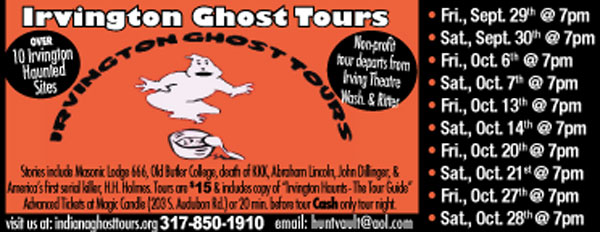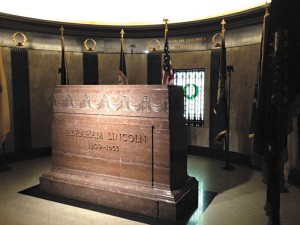The details of Lincoln’s death by assassination are well known by Americans young and old and need not be recounted here. I have done my level best over the years to inform Hoosiers of the mournful Lincoln funeral train that brought Mr. Lincoln through Indiana and Irvington, so we won’t revisit that journey either. What is lesser known is the attempt to kidnap the martyred President’s corpse from it’s peaceful repose in quiet Oak Ridge cemetery by a gang of ruthless counterfeiters. And of course, it has a Hoosier connection.
On the night of November 7th, 1876 a gang of Chicago Irish counterfeiters broke into the hallowed tomb at Springfield and actually succeeded in cracking open the sarcophagus and partially removing the casket that contained the remains of Abraham Lincoln. An unthinkable national atrocity today, but barely even a crime back then.
The hapless gang was organized by Windy City crime boss Big Jim Kennelly, leader of one of the nation’s largest counterfeiting rings headquartered in central Illinois. Early in 1876, Kennelly’s most talented counterfeit plate engraver, Benjamin Boyd, was arrested and sentenced to a ten year stretch in the state penitentiary in Joliet, Illinois. Big Jim Kennelly had literally lost the goose that laid the golden egg. Kennelly came up with a plan to pressure the governor to release his man that was as daring as it was reckless. Kennelly recruited two men on the fringe of the criminal community, saloonkeeper Terence Mullen and occasional plug nickel manufacturer Jack Hughes, to form a crew whose purpose it was to kidnap Lincoln’s body. For ransom, the gang would demand $200,000 in gold, prosecutorial immunity and a full pardon for bogus bill-maker Boyd.
Believe it or not, as crazy as it sounds today, the plot actually made perfect sense at the time. In theory that is. After all, body snatching was a fairly common occurrence in those days, with the stolen bodies either sold to medical schools for cash (no questions asked) or held for ransom money from the decedent’s grieving family. Although Lincoln was quickly ascending to the heights of secular sainthood a decade after his untimely death, the cemetery that was his final resting place was relatively unprotected.
After all, who would ever dream of stealing Abraham Lincoln’s body? The plot, however poorly planned and haphazardly executed, actually had a good chance of succeeding. There were a couple minor details that surfaced at the start that seemed hard to overcome. Big Jim Kennelly certainly wasn’t going to get his hands dirty and neither Mullen nor Hughes had any previous body-snatching experience. So they invited a loudmouthed, boastful hoodlum they met in their Chicago headquarters bar named Lewis G. Swegles to join their gang. Swegles bragged that he was the “king of the grave robbers.” Problem was, this loudmouthed, boastful hoodlum was a paid informant (then known as a “roper”) for the United States Secret Service.
The gang decided that they would break into the unguarded tomb under cover of night, remove the padlock with a hacksaw, lift the front off the above ground marble sarcophagus, slide the casket out, put Lincoln’s body in a long sack, slide the empty casket back into place, replace the front so that no-one would notice, place Lincoln’s body into the back of a horse-drawn wagon, and then transport Honest Abe’s corpse to the Indiana Dunes where it was to be hidden in the sand hills there. After Lincoln’s body was well hidden and while the nation was in an uproar over the theft, the gang would demand the hefty ransom and go back to a life of counterfeiting. It must be noted that in 1876, the United States Treasury had not yet perfected the art of a unified national currency and their greenbacks were easily faked and hard to detect.
The plan was to break into the burial vault on a night when the entire country was sure to be preoccupied, distracted and otherwise indisposed. Thanksgiving? Christmas Eve? Fourth of July? No, none of the above. The gang chose the night of the Presidential Election. That is the ONLY thing this “gang that couldn’t shoot straight” did right during the whole affair. They lucked out beyond their wildest dreams, for the Presidential election of 1876 was one of the most disputed and controversial elections in American history.
Democrat Samuel J. Tilden of New York beat Republican Rutherford B. Hayes in the popular vote, and had 184 electoral votes to Hayes’s 165, with 20 votes uncounted. These 20 electoral votes were in dispute in three states: Florida, Louisiana, and South Carolina. The 20 disputed electoral votes were ultimately awarded to Hayes after a bitter legal and political battle, giving him the victory. Sounds familiar doesn’t it? This quirk of fate would prove to be a perfect cover for an imperfect and ill-considered crime.
One other detail working in the gang’s favor was Illinois law itself. All of the participants were hoodlums and as with all criminals they possessed a better-than-average knowledge of the law and it’s loopholes. Undoubtedly, the brash fearlessness of the tomb robbers’ plot was in part due to their knowledge that Illinois only punished convicted grave robbers with a year in county jail. In other words, they could do the crime because they could afford to do the time. This knowledge was certainly secreted safely inside their brains as the three would-be body snatchers climbed over the fence several hundred yards behind the Lincoln tomb.
At first, everything was progressing smoothly, especially for Big Jim Kennelly who was safely tending bar 200 miles away in Chicago. Mullin, Hughes and informant Swegles climbed the hill behind the tomb undetected. The glow of their oil lamps was obscured by black canvas covers to hide their approach. As they peered into the inky darkness through the bars of the ornate gated door that protected the burial chamber, the lamp’s cover was slightly lifted, illuminating the cavity. There, before them, was the gleaming white marble casement that held Abraham Lincoln’s body.
The hoodlums quickly began to saw off the lock, breaking more than one blade in the attempt. Finally the lock gave way and the grisly task stood before them. The gang pried loose the foot stone upon which the immortal words from Lincoln’s second Inauguration address, “With Malice Towards None, With Charity For All” were artfully carved onto. Now all that separated the robbers from the hallowed remains of our sixteenth President was a thin layer of wood in the form of a coffin. For a moment, even these hard-hearted bandits could not help but stop and stare in awe at the thought of what they were about to do. But only for a moment.
Unbeknownst to two of the three would-be grave robbers, a crew of detectives were hiding mere yards away in the tomb’s memorial hall. The lawmen waited patiently in the dark for the right moment to spring into action and nab the body bandits before they could steal Lincoln’s body. The first custodian of the Lincoln tomb, John Carroll Power, waited alongside them. The detectives had been tipped off by their man on the inside, Louis G. Swegles, and were now awaiting for his sign to emerge. These seasoned detectives were so nervous about the outcome that, while waiting, they removed their boots to ensure that they made no noise while walking around the marble floors of the tomb.
The awe of the moment quickly wore off and the bandits got to work tugging, sliding, grunting and groaning as they attempted to remove the coffin. The gang didn’t realize that the cedar coffin had been double lined with lead back in 1865 in an effort to retard decomposition during the nearly 3-week-long sojourn of the funeral train from Washington DC to Springfield, Illinois. The lead made it nearly impossible for the three men to budge, let alone carry away from the tomb. They managed to get one corner out of the marble casement before collapsing from exhaustion. Hughes and Mullin ordered Swegles to go get the wagon and horses to carry the coffin away from the tomb.
Swegles saw his chance, he left the tomb and circled around to the locked door of memorial hall and whispered the pre-arranged code word, “Wash” to identify himself. The massive metal door of memorial hall slowly swung open as the posse warily peered outside at the ghostly wide-eyed informant. Swegles heart was nearly beating out of his chest as he quickly explained the situation and told the detectives that now was the perfect time to catch the grave robbers red-handed. One of the detectives stepped outside and cocked his pistol in anticipation of the confrontation awaiting around the corner. The posse began to encircle the monument when suddenly, a shot rang out in the deserted graveyard. Somehow, the hair trigger of the lawman’s loaded gun had slipped from it’s mooring and the pistol shot harmlessly into the air. Although no one was injured, the gunshot sounded like cannon fire in the quiet bone yard.
The detectives scurried around to the burial chamber. They leapt in expecting to catch the bandits in the act, but the chamber was empty. Only a few tools remained scattered about the ground as proof that the gang was ever there to begin with. The lawmen were too excited to notice the broken sarcophagus in the darkness. They exited the tomb in pursuit of the bandits, whom they were certain were cowering somewhere in the cemetery or perhaps even in another part of the tomb itself. Guns, graves, darkness, and adrenaline. Yeah, this was going to work out just fine.
Stay tuned for Part 2.
Al Hunter is the author of the “Haunted Indianapolis” and co-author of the “Haunted Irvington” and “Indiana National Road” book series. His newest book is “Bumps in the Night. Stories from the Weekly View.” Contact Al directly at Huntvault@aol.com or become a friend on facebook.




